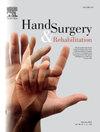Ultrasound-guided percutaneous release of the ulnar nerve at the elbow
IF 0.9
4区 医学
Q4 ORTHOPEDICS
引用次数: 0
Abstract
Introduction
Surgical treatment of ulnar tunnel syndrome is controversial, with no consensus on the ideal procedure. Nevertheless, in-situ decompression seems to provide faster recovery with less morbidity than neurolysis-transposition. The aim of this retrospective study was to validate a new percutaneous technique using ultrasonography.
Methods
A retrospective 2-center study included 40 patients with McGowan stage 1 or 2 ulnar nerve entrapment at the elbow treated by a new limited ultrasound-guided percutaneous technique. Patients with McGowan stage 3, osteoarthritis at the elbow or instability were excluded. The study endpoint was clinical success of the percutaneous technique using ultrasonography for release of ulnar nerve entrapment at the elbow. The secondary endpoint was time to recovery.
Results
All 40 patients showed clinical improvement, with the resolution of acroparesthesia symptoms. No recurrences were observed at 13 months’ follow-up. There were no cases of neurological complications, ulnar nerve instability or infection.
Patients were able to return to work rapidly, with an average absence of 3.5 weeks.
Discussion
Numerous studies questioned the value of ulnar nerve transposition associated with release in the early stages. No significant difference was found between in-situ decompression and transposition; however, more complications were observed in patients with transposition.
Conclusion
Overall, this new ultrasound-guided percutaneous technique for ulnar nerve entrapment was safe. It allowed rapid recovery with effective symptom relief while limiting the risk of complications and time off work.
超声引导下经皮肘部尺神经松解术。
尺管综合征的手术治疗是有争议的,对理想的手术方法没有共识。然而,原位减压似乎比神经松解转位恢复更快,发病率更低。本回顾性研究的目的是验证一种新的经皮超声技术。方法:回顾性两中心研究包括40例McGowan一期或二期肘尺神经卡压患者,采用新的有限超声引导经皮技术治疗。排除McGowan期3、肘部骨关节炎或不稳定的患者。研究的终点是临床成功的经皮技术使用超声检查解除肘尺神经卡压。次要终点是恢复时间。结果:40例患者均有临床改善,肢端感觉异常症状得到缓解。随访13个月无复发。无神经系统并发症、尺神经不稳或感染病例。患者能够迅速重返工作岗位,平均缺勤时间为3.5周。讨论:许多研究质疑尺神经转位与早期释放相关的价值。原位减压与移位无显著性差异;然而,转位患者的并发症较多。结论:总的来说,超声引导下经皮尺神经夹持术是安全的。它允许快速恢复,有效缓解症状,同时限制并发症的风险和休息时间。
本文章由计算机程序翻译,如有差异,请以英文原文为准。
求助全文
约1分钟内获得全文
求助全文
来源期刊

Hand Surgery & Rehabilitation
Medicine-Surgery
CiteScore
1.70
自引率
27.30%
发文量
0
审稿时长
49 days
期刊介绍:
As the official publication of the French, Belgian and Swiss Societies for Surgery of the Hand, as well as of the French Society of Rehabilitation of the Hand & Upper Limb, ''Hand Surgery and Rehabilitation'' - formerly named "Chirurgie de la Main" - publishes original articles, literature reviews, technical notes, and clinical cases. It is indexed in the main international databases (including Medline). Initially a platform for French-speaking hand surgeons, the journal will now publish its articles in English to disseminate its author''s scientific findings more widely. The journal also includes a biannual supplement in French, the monograph of the French Society for Surgery of the Hand, where comprehensive reviews in the fields of hand, peripheral nerve and upper limb surgery are presented.
Organe officiel de la Société française de chirurgie de la main, de la Société française de Rééducation de la main (SFRM-GEMMSOR), de la Société suisse de chirurgie de la main et du Belgian Hand Group, indexée dans les grandes bases de données internationales (Medline, Embase, Pascal, Scopus), Hand Surgery and Rehabilitation - anciennement titrée Chirurgie de la main - publie des articles originaux, des revues de la littérature, des notes techniques, des cas clinique. Initialement plateforme d''expression francophone de la spécialité, la revue s''oriente désormais vers l''anglais pour devenir une référence scientifique et de formation de la spécialité en France et en Europe. Avec 6 publications en anglais par an, la revue comprend également un supplément biannuel, la monographie du GEM, où sont présentées en français, des mises au point complètes dans les domaines de la chirurgie de la main, des nerfs périphériques et du membre supérieur.
 求助内容:
求助内容: 应助结果提醒方式:
应助结果提醒方式:


